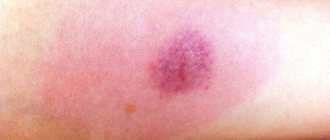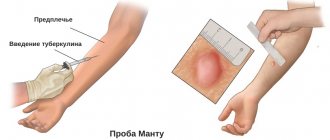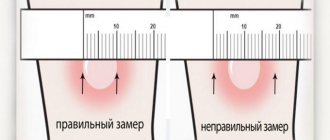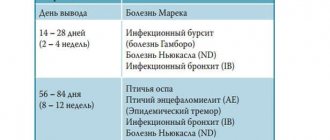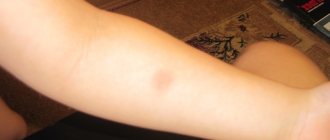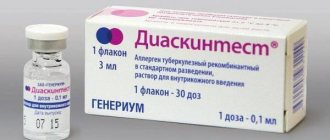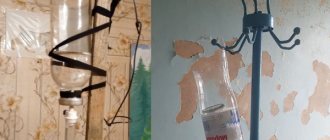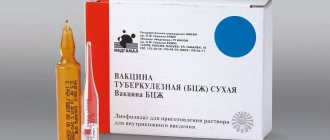Indications for Tuberculin vaccination
Tuberculin is used for tuberculin diagnostics (carrying out an intradermal Mantoux tuberculin test), which is an indicative diagnostic test for the purpose of:
- identifying the need for a patient to be vaccinated against tuberculosis with BCG
- diagnosis of tuberculosis;
- determining whether the population is infected with Mycobacterium tuberculosis (or the state of hypersensitivity to tuberculin, if the existing post-vaccination allergy does not give grounds to talk about infection).
The active substance of the drug (allergen-tuberculoprotein) causes, when performing an intradermal tuberculin test in people infected or vaccinated with BCG/BCG-M, a specific delayed-type hypersensitivity reaction in the form of a local reaction - hyperemia (redness) and infiltrate (papule formation).
What should Mantoux look like?
The answer to the question on what day Mantoux should be tested in a child is closely related to how the mark on the arm from the vaccine administration visually changes. On the first day after the injection, the area around the injection may become red and slightly swollen.
You may experience itching and a slight rise in temperature at the injection site.
During the first day, it is important not to wet the injection site and, if possible, to avoid friction with clothing. Do not smear the injection site with brilliant green, iodine or cover it with a band-aid.
In adults and children over 14 years of age, redness may be minimal or not appear at all.
After another day, a papule should form around the injection site - this is a slightly reddened area of tissue, denser than the rest of the skin. When pressed, the papule should turn white. On the second day, its boundaries may not be so clear and it may partially merge with the swollen area around it.
On the third day, the Mantoux test is completely formed, the redness should subside, and the papule should have clear boundaries. Normally, there should be no inflammation or areas of dead tissue. The sample on day 3 should be assessed along the boundaries of the papule, not paying attention to the redness around it.
As already mentioned, the sample size can depend on many factors, the most significant of which is the age of the child. You need to focus on the size of the previous sample, namely how much the current reaction exceeds the size of the previous one.
In children aged one year, Mantoux can reach a size of 15 mm, which is a normal indicator of the process of immunity formation. At the same age, together with Mantoux, the size of the BCG scar is assessed. The sizes of both samples must be proportional to each other. The size of Mantoux in the next two years may also exceed the norm if it decreases each time. At 3 years of age, the size of the papule should not be more than 5-8 mm, and only in subsequent years is the norm considered to be a papule of no more than 5 mm in the absence of allergic reactions.
A false positive reaction is a reaction above the age norm, which is possible if the sample is not properly cared for. For example, if the injection site is wet in the first hours after the injection, or kept in hot water for a long time, or rubbed, the test may give a false positive result. The same can happen if the test is done during a seasonal exacerbation of allergies or after eating citrus fruits or chocolate.
Thus, the norm of the Mantoux reaction is quite blurred, but some signs remain that allow timely detection of a pathological immune response to the sample drug.
Evaluation of Mantoux test results
The test result is assessed by a doctor or trained nurse 72 hours after the test. A reaction to tuberculin is possible in the form of hyperemia (redness of the skin) and the formation of a papule (a dense round area rising above the skin). Assessment of the Mantoux test consists of taking into account the size of the papule and assessing the severity of hyperemia. The measurement is carried out in a direction transverse to the axis of the hand, the result is taken into account in millimeters. Only the size of the papule is measured, and not the size of the area of hyperemia (redness). The size of the redness is taken into account only when the papule has not occurred.
Reaction options for the Mantoux test:
- negative - there are no changes on the skin;
- doubtful - there is redness of any size without a papule, or a papule no more than 2-4 mm;
- positive mild - papule size 5-9 mm;
- positive of medium intensity - papule size 10-14 mm;
- positive pronounced - papule size 15-16 mm;
- excessive (hyperergic) - the size of the papule exceeds 17 mm or there are pronounced signs of inflammation (reaction of the lymph nodes, skin ulceration, etc.).
- A negative Mantoux reaction indicates that the body does not have antibodies that are “familiar” with the tuberculosis bacterium. This means that the child is not infected, or there is no immune reaction to BCG vaccination.
- A questionable sample is considered negative.
- A positive test can be either a consequence of BCG vaccination or a sign of infection.
To assess the likelihood of infection, you need to look at the turn of the tuberculin test - the transition of a negative Mantoux reaction to a positive one (not associated with previous vaccination) or an increase in the diameter of the papule compared to the result of the previous test by 6 millimeters or more.
Also signs of infection are:
- hyperergic reaction;
- persistent (more than 4 years) persistent reaction with a papule of 12 mm or more;
- gradual (over several years) increase in sensitivity to tuberculin with the formation of an infiltrate measuring 12 mm or more.
A positive Mantoux test result without taking into account other diagnostic criteria is not a basis for making a diagnosis or starting any treatment.
Only a doctor can evaluate the reaction; if necessary, the child will be referred for additional examination to a TB specialist.
Mantoux reaction size indicators by age
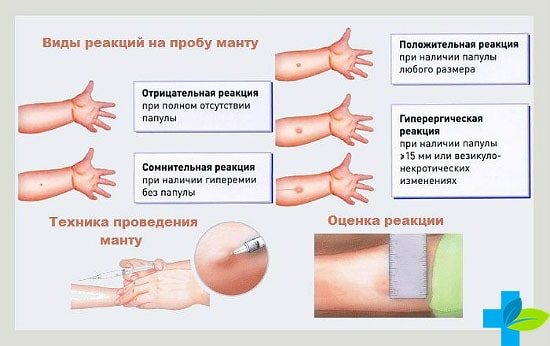
The norm of Mantoux indicators varies depending on age. In children, the size of the papule should be smaller than in adults.
The first check is done at 12 months, that is, a year after the administration of the BCG vaccine (against tuberculosis).
The size of the button in this case depends on whether the child has developed immunity or not. When the vaccine affects the body correctly, the readings will vary from 5 to 11 mm. If there is no reaction, it means that the defense has not formed, and you need to check the baby more often.
At the age of 2 to 4 years, the above indicators remain approximately the same. Most children have papules larger than 5 mm but smaller than 10 mm.
By the age of 5-6 years, the baby practically loses immunity to Koch's bacillus, and therefore the reaction to tuberculin becomes weaker. During this period, the button does not exceed 6 mm in size.
At 7 years of age, BCG vaccination can be repeated. The body’s further reaction to Mantoux depends on whether another vaccination was given.
If BCG was administered, the papule increases and then decreases. At 8 years old it can reach 11 mm, and by 14 it decreases again to 5 mm.
In unvaccinated children between the ages of 7 and 14, a false or questionable reaction persists: the papule is no more than 4 mm.
For adults (starting from 14 years old), the Mantoux size should not be larger than 16 or 20 mm (for teenagers and people over 18, respectively). If the button exceeds 17 or 21 mm, the reaction is considered positive.
Indications for the Mantoux test
The Mantoux test is performed to diagnose tuberculosis.
Children vaccinated against tuberculosis:
The Mantoux test (Intradermal allergy test with tuberculin) is performed once a year, regardless of the results of previous tests, at the age of 1 to 7 years inclusive.
For children not vaccinated against tuberculosis (children who have not been vaccinated with BCG), the Mantoux test is performed 2 times a year starting at the age of 6 months
Children not vaccinated against tuberculosis:
The Mantoux test is performed - 2 times a year, starting from the age of 6 months, the Mantoux test is performed.
Mantoux reaction: a short excursion into history
Immediately after the German microbiologist Robert Koch discovered the existence of the tuberculosis bacillus in 1882 (a little later it became commonly called “Koch’s bacillus”, and in modern medicine it more often appears under the name “mycobacterium tuberculosis”), many scientists began searching for a cure for terrible disease.
The first of them was, of course, Robert Koch himself. He subjected the tuberculosis bacteria to a lot of “torture” - he boiled them, tested the effects of various chemical compounds on them, “added” other bacteria to them, etc. And finally, he created a substance to which he gave the name tuberculin. Robert Koch sincerely believed that tuberculin would save humanity from one of the most ancient and deadly diseases - tuberculosis.
Tuberculin began to be practiced on people, but over time it became clear that in treating the disease it was almost as helpless as ordinary boiled water. True, as you know, there is no silver lining...
At this very moment, a hitherto unknown French physician Charles Mantoux appeared on the stage of history, who for the first time in 1908 proposed the use of tuberculin... as a diagnostic test for the presence of tuberculosis! Since the observant Charles noticed that when the drug is introduced into the body, people with tuberculosis and people who do not have it react completely differently. Over time, this test began to bear the name of the observant Frenchman - the Mantoux test.
From the beginning of the 20th century to the present day, the Mantoux test (or otherwise the “Mantoux reaction”, and sometimes the “Mantoux graft”) has been carried out all over the world, usually once a year. The schedule for performing the Mantoux test in children is especially carefully monitored.
Contraindications
Only a doctor can decide whether the drug “Tuberculin” is suitable for testing for tuberculosis.
“Tuberculin” is contraindicated for persons with allergic and autoimmune diseases!
The use of Tuberculin is also contraindicated in the following cases:
- common skin diseases
- epilepsy
- acute, chronic infectious and somatic diseases during exacerbation; allergic conditions (rheumatism in acute and subacute phases, bronchial asthma, idiosyncrasies with pronounced skin manifestations during exacerbation).
It is not allowed to carry out the Mantoux test in those children's groups where there is a quarantine for childhood infections. The Mantoux test is performed 1 month after all clinical symptoms disappear or immediately after quarantine is lifted.
How to measure Mantu at home
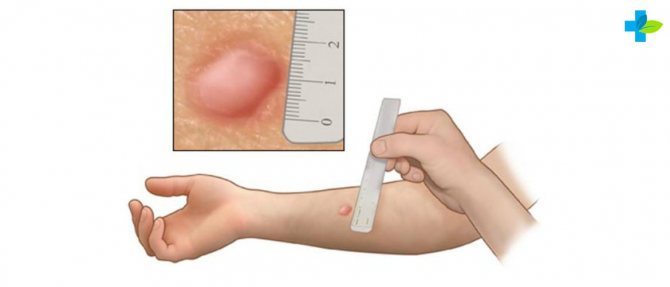
Mantoux is measured using a ruler. It is desirable that it be transparent: this makes it easier to see the outlines of the papule.
Before starting the measurement, it is recommended to circle the button (namely the protruding part, and not the entire area of redness of the skin) with a pen, especially if it is difficult to see.
How to measure Mantu at home step by step:
- Place a ruler on the papule. The tool should be positioned across your hand. Even if the seal is slightly oval in shape, this method will allow you to take the correct readings.
- Mantoux should be measured on the fourth day after tuberculin administration, preferably after 72 hours.
- See the table for explanations by age. If the readings are higher than normal, it is recommended to inform your doctor.
Not everyone can measure a papule correctly the first time. Therefore, you need to rely on a professional (doctor, nurse in an educational institution), and not on home tests.
Possible side effects
- For most, the test process is asymptomatic.
- Headaches may rarely occur
- General weakness, sleep disturbances, and increased body temperature rarely develop.
- Individuals with altered reactivity experience allergic reactions.
- Considering the possibility of developing immediate allergic reactions (anaphylactic shock, Quincke's edema, urticaria) in particularly sensitive individuals, vaccinated persons must be provided with medical supervision for 30 minutes.
Come get vaccinated at Aqua-Doctor. A full range of vaccines for children and adults, family vaccinations - at a special price!
Call a doctor at home Make an appointment with a doctor Or by phone +7
Is it possible to carry out tuberculin diagnostics and vaccination against tuberculosis at the same time?
Mantoux and BCG analysis are not performed at the same time. Tuberculin diagnostics is intended to identify the presence of a dangerous infection in the body and understand whether it is worth getting vaccinated. Therefore, you first need to evaluate the Mantoux results, and then (if the reaction is negative) administer the BCG drug.
If a child is often sick, has chronic pathologies, and his body weight is below normal, then he is vaccinated with BCG-M. This drug also contains live tuberculosis microbacteria, but their concentration is half that in BCG.
If the immune system is weakened, a standard vaccination can cause complications and cause adverse reactions. BCG-M is much easier to tolerate.
Thus, the national schedule suggests performing the Mantoux test annually for children vaccinated with BCG, and once every six months for those who have not received the vaccine. This test is safe and allows you to detect the presence of Koch's bacillus in the body. But in order to get a reliable result, it is necessary to properly handle the injection site, maintain an interval between the Mantoux test and the administration of serum to form specific immunity.
